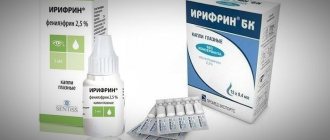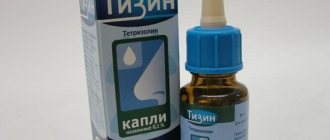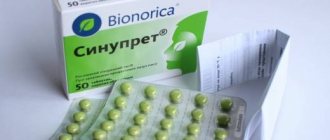Release form, composition and packaging
Eye drops 0.5% colorless, transparent.
| 1 ml | |
| tropicamide | 5 mg |
Excipients: sodium chloride, disodium edetate dihydrate, benzalkonium chloride, hydrochloric acid, purified water.
10 ml - plastic bottles (1) with a dropper stopper - cardboard packs.
Eye drops 1% colorless, transparent.
| 1 ml | |
| tropicamide | 10 mg |
Excipients: sodium chloride, disodium edetate dihydrate, benzalkonium chloride, hydrochloric acid, purified water.
10 ml - plastic bottles (1) with a dropper stopper - cardboard packs.
Contraindications
Contraindications for the use of drops are:
- The patient has mixed primary or angle-closure glaucoma, as well as suspicion of this disease;
- Intolerance to drug substances;
- Intraocular hypertension.
The use of Tropicamide during pregnancy is possible only under the supervision of a doctor, taking into account the ratio of the probable benefit to the mother and the potential risk to the child.
The drug is used with extreme caution during breastfeeding.
TROPICAMIDE: DOSAGE
The drug should be administered conjunctivally.
Eye drops 0.5%
For diagnostic dilatation of the pupil, the drug is instilled in 1-3 drops over 10 minutes. With 3-time instillation, ophthalmoscopy can be performed after 10 minutes.
To determine refraction, the drug is instilled 6 times with an interval of 6-12 minutes.
When used for medicinal purposes, the drug is instilled up to 6 times a day.
Eye drops 1%
For the effect of cycloplegia, when studying refraction, instill 1-2 drops of the solution; instillation is repeated after 5 minutes. If the patient has not been examined within 20-25 minutes, you can additionally instill 1 drop to prolong mydriasis.
TROPICAMIDE
Drug: TROPICAMIDE
Active substance: tropicamide ATC code: S01FA06 KFG: M-cholinergic receptor blocker for topical use in ophthalmology (mydriatic) ICD-10 codes (indications): H10.2, H10.4, Z01.0, Z29.8, Z51.4 Code KFU: 02.26.01 Reg. number: P No. 015023/01-2003 Registration date: 07/01/08 Owner reg. credential: WARSAW PHARMACEUTICAL WORK POLFA SA {Poland}
DOSAGE FORM, COMPOSITION AND PACKAGING
Eye drops 0.5% colorless, transparent.
| 1 ml | |
| tropicamide | 5 mg |
Excipients: sodium chloride, disodium salt of ethylenediaminetetraacetic acid, benzalkonium chloride, hydrochloric acid, water for injection.
5 ml - polyethylene dropper bottle (1) - cardboard packs. 5 ml - polyethylene dropper bottle (2) - cardboard packs.
Eye drops 1% colorless, transparent.
| 1 ml | |
| tropicamide | 10 mg |
Excipients: sodium chloride, disodium salt of ethylenediaminetetraacetic acid, benzalkonium chloride, hydrochloric acid, water for injection.
5 ml - polyethylene bottles (1) - cardboard packs. 5 ml - polyethylene bottles (2) - cardboard packs.
INSTRUCTIONS FOR TROPICAMIDE FOR SPECIALISTS. The description of the drug is approved by the manufacturer.
PHARMACHOLOGIC EFFECT
Mydriatic. Blocks m-cholinergic receptors of the sphincter of the iris and ciliary muscle, quickly and for a short time dilates the pupil and paralyzes accommodation. Pupil dilation begins 5-10 minutes after a single instillation of the drug into the conjunctival sac, reaches a maximum after 15-20 minutes and persists for 1 hour with instillation of 0.5% drops and 2 hours with instillation of 1% drops. Complete restoration of pupil size occurs after 3-5 hours.
Maximum paralysis of accommodation after instillation of 1% Tropicamide drops 2 times with an interval of 5 minutes occurs after 25 minutes and lasts about 30 minutes. Complete recovery occurs in approximately 3 hours.
PHARMACOKINETICS
After instillation of the drug into the conjunctival sac, tropicamide is slightly subject to systemic absorption (especially in children and the elderly).
INDICATIONS
For diagnostic purposes:
— if necessary, mydriasis when examining the fundus and assessing the condition of the lens;
- if paralysis of accommodation is necessary during refractive examination.
Before surgery:
— lens surgery;
— laser therapy of the retina;
— retinal and vitreous surgery.
For therapeutic purposes:
- as a component of complex therapy for inflammatory eye diseases and in the postoperative period to prevent the development of synechiae.
DOSING REGIME
The drug is instilled into the conjunctival sac.
To dilate the pupil, instill 1 drop of 1% or 2 drops of 0.5% solution (at 5-minute intervals). After 10 minutes, ophthalmoscopy can be performed. If the effect is insufficient (very high light intensity, used to rupture posterior synechiae), it can be used together with phenylephrine.
To achieve paralysis of accommodation (during refraction studies), instill 1 drop of a 1% Tropicamide solution 6 times with an interval of 6-12 minutes. The study is preferably performed within 25-50 minutes from the moment of the last instillation of the drug.
In infants and children under 6 years of age, only 0.5% eye drops should be used.
In premature infants, systemic anticholinergic effects of tropicamide have been observed in isolated cases, increasing with repeated use. These adverse events can be prevented without reducing effectiveness by diluting the drug with isotonic sodium chloride solution (1:1).
During instillation of the drug, light pressure should be applied to the lacrimal ducts to limit excessive absorption of tropicamide and prevent the systemic anticholinergic effect of the drug.
The dosage regimen for therapeutic purposes is set individually (depending on the patient’s condition).
SIDE EFFECT
From the organ of vision: increased intraocular pressure; impaired visual acuity; photophobia.
From the side of the central nervous system: sometimes - psychotic symptoms, behavioral disturbances (especially in children and adolescents); headaches (in adults).
From the cardiovascular system: symptoms of circulatory and respiratory failure (especially in children and adolescents); tachycardia (in adults).
Other: dry mouth, allergic reactions.
CONTRAINDICATIONS
- glaucoma (especially angle-closure and mixed primary);
- hypersensitivity to the components of the drug.
PREGNANCY AND LACTATION
The use of Tropicamide during pregnancy is possible only in cases where the expected benefit to the mother outweighs the potential risk to the fetus.
The drug should be used with caution during lactation (breastfeeding).
SPECIAL INSTRUCTIONS
Before using Tropicamide to dilate the pupil, before examining the fundus, it is necessary to examine the patient to identify possible angle-closure glaucoma (check the medical history, assess the depth of the anterior chamber, gonioscopy), because Acute attacks of glaucoma are possible after using the drug.
Before using Tropicamide for diagnostic purposes, the patient or accompanying person should be warned about temporary visual disturbances and photophobia.
Do not touch the tip of the dropper as this may cause contamination of the contents of the bottle.
Before using Tropicamide, you must remove soft contact lenses. They can be installed again no earlier than 30 minutes after instillation of the drug.
Use in pediatrics
Before using Tropicamide for diagnostic purposes in children, the accompanying person should be warned about temporary visual disturbances and photophobia.
Use of the drug in infants and young children may cause central nervous system disorders.
Impact on the ability to drive vehicles and operate machinery
When using Tropicamide, you should not drive vehicles or operate machinery.
OVERDOSE
Currently, no cases of overdose of Tropicamide (when instilled into the conjunctival sac) have been reported.
DRUG INTERACTIONS
The simultaneous use of anticholinergics and histamine H1 receptor blockers, phenothiazines, tricyclic antidepressants, procainamide, quinidine, MAO inhibitors, benzodiazepines and antipsychotics mutually enhances each other's effects.
The paralysis of accommodation caused by tropicamide is enhanced by its simultaneous use with sympathomimetic drugs and weakened by its simultaneous use with parasympathomimetic drugs.
With the simultaneous use of Tropicamide and nitrates, nitrites, alkalizing drugs, disopyramide, corticosteroids and haloperidol, intraocular pressure may increase with concomitant angle-closure glaucoma.
CONDITIONS OF VACATION FROM PHARMACIES
The drug is available with a prescription.
CONDITIONS AND DURATION OF STORAGE
The drug should be stored away from light and out of the reach of children at a temperature of 15° to 25°C. Shelf life: 3 years.
After opening the bottle, the shelf life is 4 weeks.
special instructions
The drug contains the preservative benzalkonium chloride, which can be deposited on the surface of soft contact lenses. In this regard, it is not recommended to use soft contact lenses during the treatment period. Hard contact lenses should be removed before instillation and installed no earlier than 15 minutes after the procedure.
To reduce the resorptive effect of the drug, it is recommended to apply light pressure with a finger on the area of the lacrimal sac for 2-3 minutes after instillation.
Impact on the ability to drive vehicles and operate machinery
During treatment with Tropicamide, care must be taken when driving vehicles and engaging in potentially hazardous activities that require increased concentration and speed of psychomotor reactions.
What is tropicamide: instructions
Reading the instructions for using tropicamide, we dwell on overdose and side effects and contraindications.
- Contraindications: glaucoma, allergic reactions.
- Side effects: burning sensation, blurred vision, attacks of glaucoma, photophobia, etc.
- Overdose: When applied topically as prescribed by a doctor, overdose is unlikely - the answer to most instructions for use.
Sign up for addiction treatment: ☎ +7(495)773-03-43
Nothing life-threatening, everything is absolutely safe. Yes, at first glance it is safer than activated carbon. But looking into the dark corners of the Internet and surfing websites for drug addicts, interesting information emerged... Those who are used to getting pleasure from taking various drugs are tirelessly looking for something new. They often have to re-read many pharmacological reference books, in which they find medications containing drugs. One of the medications that drug addicts misuse is tropicamide. This medicine is an M-choline blocker. This group of medications gets its name from the function they perform in the human body. These substances interfere with the transmission of nerve impulses passing through receptors in the central nervous system called M-cholinergic receptors.
In what cases should Tropicamide not be used?
Being an organic M-anticholinergic blocker, Tropicamide (eye drops) is used to paralyze the pupil - its forced dilation for a short time. The drug has a local effect, not being systemic, although, quickly absorbed into the blood, it acquires the properties of a systemic drug. Its use is contraindicated in some cases. This medicine should strictly not be used for angle-closure and primary mixed glaucoma. These are two separate types from a fairly large number of eye diseases caused by an increase in intraocular pressure above the permissible level. With a form of glaucoma such as angle-closure, the outflow of intraocular fluid can be blocked by pupil dilation under the influence of Tropicamide.
Interaction with other drugs
The drug, due to its strong action and components in its composition, can interact with many agents and substances.
If Tropicamide is used simultaneously with anticholinergic, antiallergic or sedative substances, benzodiazepines, monoamine oxidase inhibitors, Quinidine, Procainamide or antipsychotic drugs, the effect of each substance may increase.
The presence of glaucoma and simultaneous use of nitrates or nitrites, alkalizing agents, disopyramide or glucocorticosteroids with the drug increases eye pressure.
Analogs
The following drugs have a similar therapeutic effect:
- Mydriacyl. Tropicamide-based eye drops. They exhibit the same pharmacological effects as Tropicamide. Available in several dosages. Manufacturer: Belgium.
- Unitropic. Another analogue based on tropicamide. Contains benzalkonium chloride as an excipient, which can cause irritation and other adverse reactions. The drug is not used in children under three years of age. Manufacturer: Slovakia.
- Atropine. Eye drops that contain atropine sulfate. They are used for diagnostic dilatation of the pupil, as well as in complex therapy of inflammatory ophthalmological diseases. The drug is contraindicated during pregnancy, and can only be used in children from 7 years of age. Belongs to the prescription group. Manufacturer – Ukraine.
- Midriaticum-Stulln. The drug is available in disposable containers of 0.4 ml. The main active ingredient is Tropicamide. Can be used in children from a very early age. Manufacturer: Germany. The cost of Tropicamide is on average 120 rubles. Prices range from 73 to 162 rubles.
Description of the drug
Tropicamide is currently available only in the form of a solution for eye drops and is a clear and colorless liquid. The active component of the drug is tropicamide, but in addition to it, the composition contains sodium chloride, purified water, hydrochloric acid, sodium ETDA and benzalkonium chloride.
Tropicamide drops
The concentration of tropicamide in these eye drops can be 0.5% or 1% depending on the release version. The composition is sold in ten milliliter plastic packaging with a dispenser. The kit also includes a cardboard box and a paper insert with description and instructions.
The drug should be stored at room temperature out of the reach of children. The shelf life of unopened packaging is three years, and if opened it is no more than four weeks.
Indications for use
The ophthalmic product is used to increase the quality of diagnostic procedures for examining the fundus of the eye. Fixing the pupil in a dilated position helps to identify subtle signs of adhesions or inflammatory processes in tissues. Also, due to the properties of the drug, refraction is determined by skiascopy.
With a dilated pupil, it is possible to adequately assess the condition of the lens, which is important in the preoperative period. The drug is administered before surgery on the vitreous body, retina, etc.
cases
The drug is administered before surgery on the vitreous body, retina, and other cases.
The ophthalmic solution is used for therapeutic purposes in the treatment of inflammatory processes developing in the anterior portion of the choroid. It is also practiced to use the medicine after operations (lens implantation, removal of glaucomatous opacities and formations).
Precautionary measures
Do not place the pipette or dropper on tables or other surfaces: it is important to prevent infection of the eye during instillation.
If you wear contact lenses, they must be removed before the procedure. Correction devices can be reinserted half an hour after Tropicamide is administered: this recommendation applies to hard lenses. It is better to abandon the soft option altogether for the period of treatment with these drops. The fact is that benzalkonium chloride, which is part of these eye drops (as well as many others), has a destructive effect on soft lenses. But how to use renu solution for contact lenses will help you understand the information at the link.
Tropicamide and drugs
The effect of eye drops is similar to atropine.
Addicts use an intravenous solution that, when it enters the circulatory system, causes a short-term feeling of relaxation, peace and warmth.
When instilled into the nose, what effect will be difficult to predict, but the duration does not exceed 30-40 minutes.
The presence of hallucinations and the dynamics of mental activity in each drug addict manifests itself individually. But to the question: why is a combination of eye drops with strong drugs used, the answer is simple - to enhance the effect of the drug when using a small dosage.
Tropicamide is used by drug addicts to change the psycho-emotional state after taking heroin or to give up stronger drugs.
Regular use of eye drops for a month forms a strong attachment to the drug. The desire to enhance the effect leads to an increase in the dose, which provokes such consequences as: tachycardia, surges in blood pressure, convulsions, paralysis of the respiratory center in the brain.
The substance is psychoactive, the price is more than affordable, therefore the main condition for dispensing Tropicamide is a prescription.
Action
Tropicamide is an eye drop that has a pronounced ability to dilate the pupil. Along with this main effect, Tropicamide temporarily prevents the constriction of the pupil (paralysis of accommodation), allowing the eye to be diagnosed in the most convenient way for a specialist. It will also be useful to know what good eye drops are to improve vision.
Most often, the drug is used in ophthalmology for a thorough analysis and examination of the fundus. The medicine can also be used in the treatment of eye adhesions, as well as to eliminate various types of inflammatory processes.
Interesting on the topic! Find out how to check the fundus and what such a study provides.
The effect of pupil dilation after instillation of the drug begins to be noticeable after 5-10 minutes, and reaches its peak after 15-20 minutes. If you instill a 0.5% solution, the effect will last an hour, if a 1% solution - two hours. The restoration of normal pupil size is recorded 3-5 hours after the procedure.
The drug is produced in one country - Poland. This medicine is not produced in other countries.
Possible complications caused by the drug
An overdose of the solution is possible when taken orally. With this phenomenon, the following symptoms may be observed:
- Dry skin and mucous membranes;
- Abnormally high degree of arousal;
- Rapid heartbeat (tachycardia, arrhythmia);
- Cramps.
If these signs occur, it is necessary to perform gastric lavage, take Physohistamine and activated charcoal and immediately consult a doctor. Local use of the drug does not imply overdose.
The drug enhances the effect of antihistamines and antidepressants, as well as drugs that contain quinidine. An increase in intraocular pressure is possible when used together with Disopyramide, Haloperidol, nitrites, nitrates and glucocorticosteroids.
Major side effects with normal use include:
- Allergic reactions;
- Fear and intolerance to light;
- Headaches and dizziness;
- Decreased visual acuity;
- Dry mouth and dry mucous membranes;
- Changes in intraocular pressure.






